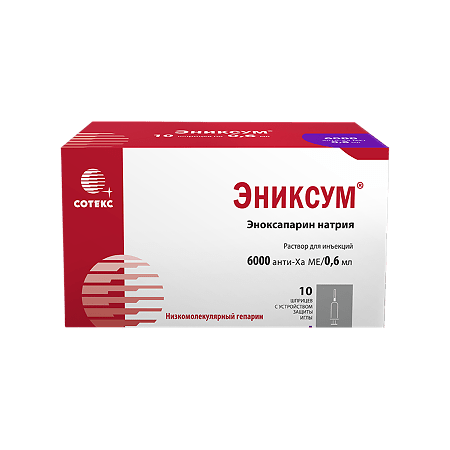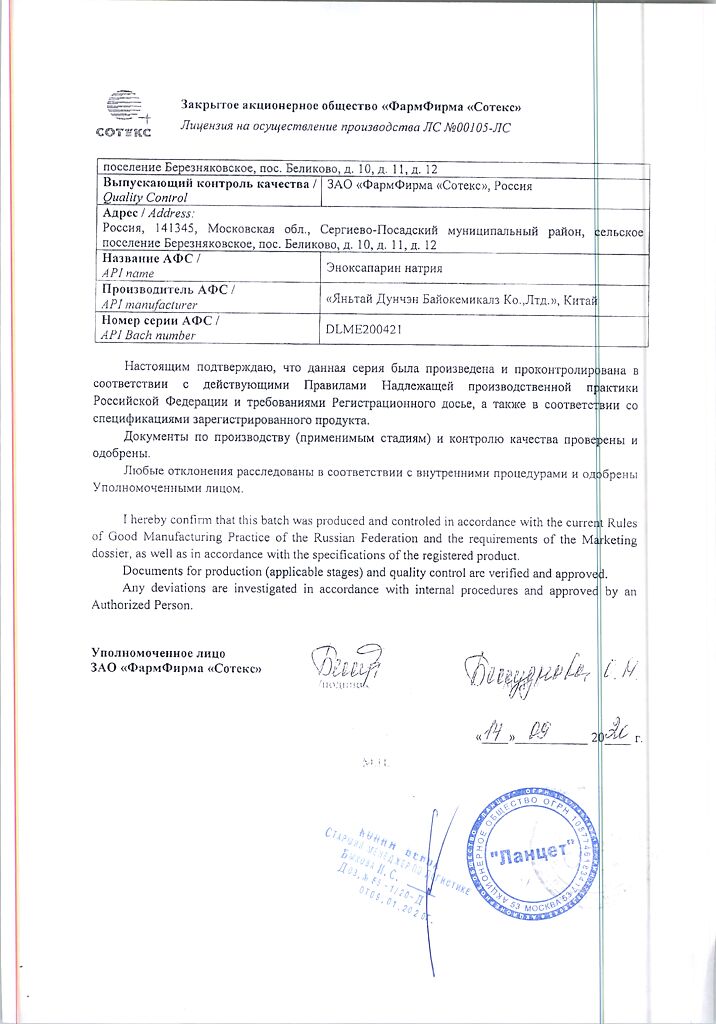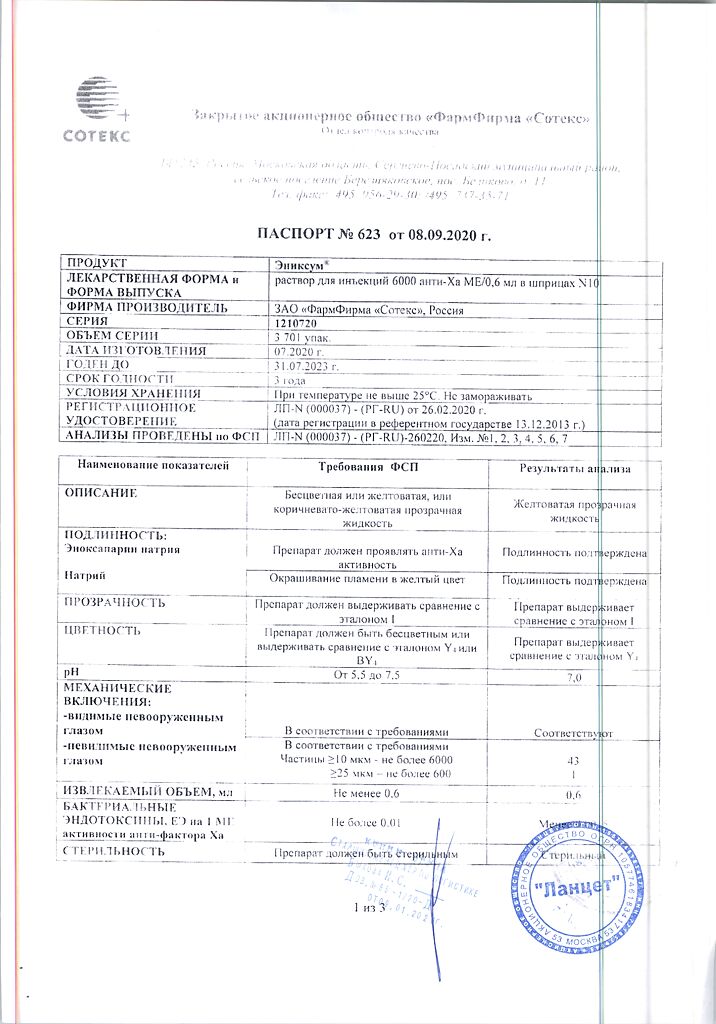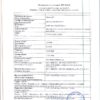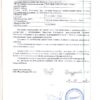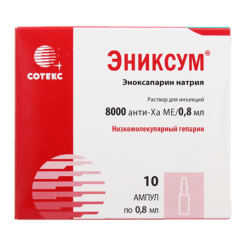No products in the cart.
Enixum, 6000 anti-ha me/0.6 mL 0.6 mL 10 pcs
€1.00
Out of stock
(E-mail when Stock is available)
Description Sodium enoxaparin is a low molecular weight heparin with an average molecular weight of about 4500 daltons (Da): less than 2000 Da – < 20%, 2000 to 8000 Da – > 68%, over 8000 Da – < 18%. Enoxaparin sodium is obtained by alkaline hydrolysis of heparin benzyl ether isolated from the mucous membrane of the small intestine of pigs. Its structure is characterized by a nonreducible fragment of 2-O-sulfo-4-enpyrazinosuronic acid and a reducible fragment of 2-N,6-O-disulfo-D-glucopyranoside. The structure of enoxaparin sodium contains about 20% (between 15% and 25%) of the 1,6-anhydro derivative in the reducing fragment of the polysaccharide chain.
Pharmacodynamics
In a purified in vitro system, sodium enoxaparin has high anti-Xa activity (approximately 100 IU/ml) and low anti-IIa or antithrombin activity (approximately 28 IU/ml). This anticoagulant activity acts through antithrombin III (AT-III), providing anticoagulant activity in humans. In addition to anti-Xa/IIa activity, additional anticoagulant and anti-inflammatory properties of enoxaparin sodium have also been identified in both healthy subjects and patients and in animal models. These include AT-III-dependent inhibition of other clotting factors like factor VIIa, activation of tissue factor pathway inhibitor (TFP) release, and reduction of Willebrand factor release from the vascular endothelium into the bloodstream. These factors provide the anticoagulant effect of enoxaparin sodium in general.
When used in prophylactic doses, it slightly changes the activated partial thromboplastin time (APT), has almost no effect on platelet aggregation and on the degree of binding of fibrinogen to platelet receptors.
Pharmacokinetics:
Bioavailability and absorption
The absolute bioavailability of enoxaparin sodium with subcutaneous (p/k) administration, estimated on the basis of anti-Xa activity, is close to 100%.
The mean maximal anti-Xa activity in plasma is seen 3-5 h after a single unit dose and reaches approximately 0.2, 0.4, 1.0 and 1.3 anti-Xa IU/ml after a single unit dose of 20 mg, 40 mg, 1 mg/kg and 1.5 mg/kg.
Intravenous bolus administration of 30 mg of the drug, accompanied by immediate subcutaneous administration of 1 mg/kg every 12 h, provides an initial maximum anti-Xa activity of 1.16 IU/ml (n=16), with a mean blood exposure of approximately 88% of the equilibrium state achieved on day 2 of therapy.
The pharmacokinetics of enoxaparin in the indicated dosing regimens is linear. Variability within and between patient groups is low.
After repeated subcutaneous administration of 40 mg of enoxaparin sodium once daily and subcutaneous administration of enoxaparin sodium at a dose of 1.5 mg/kg body weight once daily in healthy volunteers, equilibrium concentration is reached by day 2, with the area under the pharmacokinetic curve on average 15% higher than after a single injection.
After repeated subcutaneous injections of enoxaparin sodium at a daily dose of 1 mg/kg body weight twice daily, the equilibrium concentration is reached after 3-4 days with the area under the pharmacokinetic curve (AUC) on average 65% higher than after a single injection and the mean values of maximum concentrations are 1.2 IU/ml and 0.52 IU/ml respectively.
The anti-IIa activity in plasma is about 10 times lower than the anti-Xa activity. Mean maximum anti-IIa activity is observed approximately 3-4 h after subcutaneous administration and reaches 0.13 IU/ml and 0.19 IU/ml after repeated administration of 1 mg/kg body weight when administered twice and 1.5 mg/kg body weight when administered once, respectively.
Distribution
The volume of distribution of the anti-Xa activity of enoxaparin sodium is approximately 4.3 L and approximates the volume of circulating blood.
Elimination
Enoxaparin sodium is a low clearance drug. After intravenous administration for 6 h at a dose of 1.5 mg/kg body weight, the average anti-Xa plasma clearance is 0.74 L/h.
The excretion of the drug is monophasic with half-lives (T1/2) of about 5 hours (after single subcutaneous administration) and about 7 hours (after multiple administration of the drug).
Enoxaparin sodium is mainly metabolized in the liver by desulfation and/or depolymerization to form low molecular weight substances with very low biological activity. Excretion through the kidneys of active drug fragments is approximately 10% of the administered dose, and total excretion of active and inactive fragments is approximately 40% of the administered dose.
Patient special groups
Patients in the elderly (over 75 years): The pharmacokinetic profile of enoxaparin sodium does not differ in elderly patients and younger patients with normal renal function. However, as a result of decreased renal function with age, slower excretion of enoxaparin sodium may be observed in elderly patients.
Hepatic disorders: In a study involving patients with advanced liver cirrhosis who received enoxaparin sodium at a dose of 4000 ME (40 mg) once daily, a decrease in maximum anti-Xa activity was associated with an increase in the severity of liver function impairment (as assessed by the Child-Pugh score). This decrease was mainly due to a decrease in AT-III levels secondary to a decrease in AT-III synthesis in patients with impaired liver function.
Kidney function impairment: decreased clearance of enoxaparin sodium in patients with impaired renal function has been noted. After repeated subcutaneous administration of 40 mg of Enoxaparin sodium once a day there is increase of anti-Xa activity represented by area under pharmacokinetic curve (AUC) in patients with mild (creatinine clearance (CK) 50-80 ml/min) and moderate (CK 30-50 ml/min) renal dysfunction. In patients with severe renal impairment (CKR less than 30 ml/min) the AUC at equilibrium is on average 65% higher with repeated subcutaneous administration of 40 mg of the drug once daily.
Hemodialysis: The pharmacokinetics of enoxaparin sodium were comparable to those in the control population after single IV doses of 25 ME, 50 ME or 100 ME/kg (0.25, 0.50 or 1.0 mg/kg), but the AUC was twice that of the control population.
Body weight: After repeated p/q doses of 1.5 mg/kg once daily, mean AUC of anti-Xa activity at equilibrium was slightly higher in overweight patients (BMI 30-48 kg/m2) compared to patients with normal average body weight, while maximum plasma anti-Xa activity was not increased. In overweight patients with subcutaneous administration of the drug, clearance is slightly lower. If no dose adjustment is made for patient weight, after a single subcutaneous injection of 40 mg of sodium enoxaparin, anti-Xa activity will be 52% higher in women with body weight less than 45 kg and 27% higher in men with body weight less than 57 kg compared to patients with normal average body weight.
.
Indications
Indications
– Prevention of venous thrombosis and embolism in surgical interventions in moderate- and high-risk patients, especially in orthopedic and general surgical interventions, including cancer.
– Prevention of venous thrombosis and embolism in bedridden patients due to acute therapeutic conditions, including acute heart failure and decompensation of chronic heart failure (NYHA class III or IV), respiratory failure, and in severe infections and rheumatic diseases at increased risk of venous thrombosis (see section “Special Instructions”).
– Treatment of deep vein thrombosis with or without pulmonary embolism, except in cases of pulmonary embolism requiring thrombolytic therapy or surgery.
– Prevention of thrombosis in the extracorporeal circulation system during hemodialysis.
– Acute coronary syndrome:
Active ingredient
Active ingredient
Composition
Composition
How to take, the dosage
How to take, the dosage
Subcutaneously, except in special cases.
Prevention of venous thrombosis and embolism in surgical procedures in moderate to high risk patients
Patients at moderate risk of thrombosis and embolism (e.g., abdominal surgery) have a recommended dose of Enixum® 20 mg once daily subcutaneously. The first injection should be given 2 hours before the surgical intervention.
. In patients at high risk of thrombosis and embolism (e.g., orthopedic surgery, oncologic surgery, patients with additional non-surgical risk factors such as congenital or acquired thrombophilia malignant neoplasm, bed rest for more than three days, obesity, venous thrombosis in anamnesis, varicose veins of lower limbs, pregnancy) the drug is recommended in a dose of 40 mg once a day subcutaneously, with the first dose administered 12 hours before the surgical intervention. If earlier preoperative prophylaxis is necessary (e.g., in patients at high risk of thrombosis and thromboembolism awaiting delayed orthopedic surgery) the last injection should be given 12 hours before surgery and 12 hours after surgery.
The duration of treatment with Enixum is 7-10 days on average. If necessary, therapy may be continued as long as the risk of thrombosis and embolism persists and until the patient is switched to an outpatient regimen.
In major orthopedic surgeries, it may be appropriate to continue treatment after initial therapy with Enixum® at a dose of 40 mg once daily for five weeks.
In patients at high risk of venous thromboembolism who have undergone surgery, abdominal and pelvic surgery because of cancer, it may be advisable to increase the duration of Enixum® administration in a dose of 40 mg once daily for four weeks.
Prevention of venous thrombosis and embolism in patients on bed rest due to acute medical conditions
The recommended dose of Enixum® is 40 mg once daily, subcutaneously, for 6-14 days. The therapy should be continued until the patient is fully ambulatory (maximum 14 days).
The treatment of deep vein thrombosis with or without pulmonary embolism
The drug is administered subcutaneously at a rate of 1.5 mg/kg body weight once daily or 1 mg/kg body weight twice daily. The dosing regimen should be chosen by a physician on the basis of assessing the risk of thromboembolism and the risk of bleeding.
In patients without thromboembolic complications and at low risk of venous thromboembolism, the drug is recommended to be given subcutaneously at a rate of 1.5 mg/kg body weight once daily.
In all other patients, including patients with obesity, symptomatic pulmonary embolism, cancer, recurrent venous thromboembolism and proximal thrombosis (in the iliac vein), the drug is recommended at a dose of 1 mg/kg twice daily.
The duration of treatment is on average 10 days. It is recommended to start immediately the therapy with indirect anticoagulants and continue Enixum® therapy until therapeutic anticoagulant effect is achieved (INR value [International Normalized Ratio] should be 2.0-3.0).
Prevention of thrombosis in extracorporeal circulation during hemodialysis
The recommended dose of Enixum® is on average 1 mg/kg body weight. If the risk of bleeding is high, the dose should be reduced to 0.5 mg/kg body weight for dual vascular access or 0.75 mg/kg for single vascular access.
Treatment of unstable angina and myocardial infarction without ST-segment elevation
Enixum® is administered at a rate of 1 mg/kg body weight every 12 hours, subcutaneously, with concomitant use of antiplatelet therapy. Average therapy duration is at least 2 days and lasts until patient’s clinical condition stabilizes. The drug usually lasts from 2 to 8 days.
Acetylsalicylic acid is recommended for all patients with no contraindications, with an initial dose of 150-300 mg orally followed by a maintenance dose of 75-325 mg once daily.
The treatment of acute ST-segment elevation myocardial infarction, drug or percutaneous coronary intervention
The treatment begins with a single intravenous bolus injection of Enoxaparin sodium at a dose of 30 mg. Immediately thereafter, enoxaparin sodium is administered subcutaneously in a dose of 1 mg/kg of body weight. The drug is then administered subcutaneously at 1 mg/kg of body weight every 12 hours (maximum 100 mg of sodium enoxaparin for each of the first two subcutaneous injections, then 1 mg/kg of body weight for the remaining subcutaneous doses, that is, if the body weight exceeds 100 kg, the single dose may not exceed 100 mg).
As soon as possible after detection of acute myocardial infarction with ST-segment elevation, patients should be simultaneously prescribed acetylsalicylic acid and, if there are no contraindications, administration of acetylsalicylic acid (in doses of 75-325 mg) should be continued daily for at least 30 days.
The recommended duration of treatment with Enixum® is 8 days or until discharge from hospital (if hospitalization is less than 8 days).
In patients 75 years of age and older, initial intravenous bolus administration is not used. The drug is administered subcutaneously at a dose of 0.75 mg/kg every 12 hours (maximum 75 mg of enoxaparin sodium for each of the first two subcutaneous injections, then 0.75 mg/kg body weight for the remaining subcutaneous doses, that is, if the body weight exceeds 100 kg, the single dose cannot exceed 75 mg).
In patients undergoing percutaneous coronary intervention, if the last subcutaneous injection of enoxaparin sodium was given less than 8 hours before the balloon catheter inserted into the coronary artery constriction was inflated, no additional injection of enoxaparin sodium is required. If the last subcutaneous injection of sodium enoxaparin was given more than 8 hours before the balloon catheter was inflated, an additional intravenous bolus injection of sodium enoxaparin at a dose of 0.3 mg/kg should be given.
Interaction
Interaction
Enoxaparin sodium must not be mixed with other medications!
Unrecommended combinations
Combinations requiring caution
– Other drugs affecting hemostasis, such as:
– Drugs that increase potassium content
Clinical and laboratory monitoring should be performed when concomitant use with drugs that increase serum potassium content.
Special Instructions
Special Instructions
General
Low molecular weight heparins are not interchangeable, since they differ in manufacturing process, molecular weight, specific anti-Xa activity, dosing units and dosing regimen, with associated differences in their pharmacokinetics and biological activity (antithrombin activity and interaction with platelets). Therefore, it is necessary to strictly follow the recommendations for the use of each drug belonging to the class of low molecular weight heparins.
Bleeding
As with other anticoagulants, the administration of enoxaparin sodium may cause bleeding of any localization. If bleeding develops, the source of bleeding must be found and appropriate treatment administered.
Sodium enoxaparin, like other anticoagulants, should be used with caution in conditions with an increased risk of bleeding, such as:
Contraindications
Contraindications
– Hypersensitivity to enoxaparin sodium, heparin or its derivatives, including other low molecular weight heparins.
. – Active clinically significant bleeding, as well as conditions and diseases with a high risk of bleeding, including recent hemorrhagic stroke, acute gastrointestinal (GI) ulcer, presence of malignant neoplasm with high risk of bleeding, Recent brain and spinal cord surgery, ophthalmologic surgery, known or suspected esophageal varices, arteriovenous malformations, vascular aneurysms, vascular anomalies of the spinal cord and brain.
– Immune-mediated heparin-induced thrombocytopenia (history) within the past 100 days or the presence of circulating antiplatelet antibodies in the blood.
– Childhood under 18 years of age because efficacy and safety have not been established in this patient population.
Conditions in which there is a potential risk of bleeding:
– hemostasis disorders (including hemophilia, thrombocytopenia, hypocoagulation, Willebrand’s disease, etc.
– gastric or duodenal ulcer or other erosive ulcerative lesions of the gastrointestinal tract in the anamnesis;
– recent ischemic stroke;
– uncontrolled severe arterial hypertension;
– diabetic or hemorrhagic retinopathy;
– severe diabetes mellitus;
– recent or suspected neurologic or ophthalmic surgery;
– performing spinal or epidural anesthesia (potential risk of hematoma), spinal tap (recent);
– recent childbirth;
– bacterial endocarditis (acute or subacute);
– pericarditis or pericardial effusion;
– renal and/or hepatic insufficiency;
– intrauterine contraception (IUI);
– severe trauma (especially of the central nervous system), open wounds on large surfaces;
– concomitant administration of drugs affecting the hemostasis system;
– heparin-induced thrombocytopenia without a history of circulating antibodies (more than 100 days).
There are no data on the clinical use of enoxaparin sodium in the following diseases: active tuberculosis, radiation therapy (recent).
Side effects
Side effects
The side effects of enoxaparin sodium have been studied in more than 15,000 patients who participated in clinical trials, including 1,776 patients in the prevention of venous thrombosis and embolism in general surgery and orthopedic surgery; 1,169 patients in the prevention of venous thrombosis and embolism in bed-ridden patients due to acute therapeutic conditions; in 559 patients, in the treatment of deep vein thrombosis with or without pulmonary embolism; in 1578 patients, in the treatment of unstable angina and myocardial infarction without a Q wave; in 10176 patients, in the treatment of ST-segment elevation myocardial infarction.
The mode of administration of enoxaparin sodium differed depending on the indication. In the prevention of venous thrombosis and embolism in general surgery and orthopedic surgery or in patients on bed rest, 40 mg was administered subcutaneously once daily.
In the treatment of unstable angina and myocardial infarction without Q-wave, the dose of enoxaparin sodium was 1 mg/kg body weight subcutaneously every 12 hours, and in case of myocardial infarction with ST-segment elevation, an intravenous bolus of 30 mg followed by 1 mg/kg body weight subcutaneously every 12 hours was administered.
The incidence of adverse reactions was determined in accordance with the classification of the World Health Organization: Very common (⥠1/10); common (⥠1/100 and < 1/10); infrequent (⥠1/1000 and < 1/100); rare (⥠1/10000 and < 1/1000); very rare (< 1/10000), frequency unknown (cannot be calculated from available data).
Vascular disorders
Bleeding
In clinical trials, bleeding was the most common adverse reaction. These included major bleeding, observed in 4.2% of patients (bleeding was considered major if it was accompanied by a decrease in hemoglobin of 2 g/L or more, required a transfusion of 2 or more doses of blood components, or if it was retroperitoneal or intracranial). Some of these cases were fatal.
As with other anticoagulants, bleeding is possible with the use of enoxaparin sodium, especially in the presence of risk factors that contribute to bleeding, during invasive procedures or when using drugs that disrupt hemostasis.
In the description of bleeding below, the sign “*” means to indicate the following types of bleeding: hematoma, ecchymoses (except those developed at the injection site), wound hematomas, hematuria, nasal bleeding, gastrointestinal bleeding.
Very common: bleeding* during prophylaxis of venous thrombosis in surgical patients and treatment of deep vein thrombosis with or without pulmonary embolism.
Often: Bleeding* in prophylaxis of venous thrombosis in bed-ridden patients and in treatment of unstable angina pectoris, myocardial infarction without Q wave and ST-segment elevation myocardial infarction.
Infrequent: retroperitoneal bleeding and intracranial hemorrhage in patients treated for deep vein thrombosis with or without pulmonary embolism and for treatment of ST-segment elevation myocardial infarction.
Rarely: retroperitoneal bleeding in the prevention of venous thrombosis in surgical patients and in the treatment of unstable angina and myocardial infarction without Q-wave.
Thrombocytopenia and thrombocytosis
Very common: Thrombocytosis (peripheral blood platelet count greater than 400×109/L) in the prevention of venous thrombosis in surgical patients and the treatment of deep vein thrombosis with or without pulmonary embolism.
Often: Thrombocytosis in the treatment of patients with acute ST-segment elevation myocardial infarction.
Thrombocytopenia in prevention of venous thrombosis in surgical patients and treatment of deep vein thrombosis with or without pulmonary embolism and in acute ST-segment elevation myocardial infarction.
Infrequent: thrombocytopenia in prophylaxis of venous thrombosis in patients on bed rest and in treatment of unstable angina and myocardial infarction without Q-wave.
Very rare: autoimmune thrombocytopenia in the treatment of patients with acute ST-segment elevation myocardial infarction.
Other clinically significant adverse reactions, regardless of indication
The adverse reactions presented below are grouped by systemic organ class, given by the frequency of occurrence defined above and in decreasing order of severity.
Disorders of the blood and lymphatic system:
often: bleeding, thrombocytopenia, thrombocytosis;
rarely: cases of autoimmune thrombocytopenia with thrombosis; in some cases, thrombosis was complicated by the development of organ infarction or limb ischemia.
Disorders of the immune system:
often: allergic reactions.
Liver and biliary tract disorders:
very common: increased activity of “liver” enzymes, mainly increased activity of transaminases, more than three times the upper limit of normal.
Skin and subcutaneous tissue disorders:
often: urticaria, skin itching, erythema.
infrequent: bullous dermatitis.
General disorders and disorders at the injection site:
often: injection site hematoma, injection site pain, injection site swelling, bleeding, hypersensitivity reactions, inflammation, formation of lumps at the injection site.
Infrequent: irritation at the injection site, necrosis of the skin at the injection site.
Data obtained after the drug was placed on the market
The following adverse reactions have been reported in the post-marketing use of enoxaparin sodium. There have been spontaneous reports of these adverse reactions.
Disorders of the immune system:
Rarely: anaphylactic/anaphylactoid reactions, including shock.
Nervous system disorders:
often: headache.
vascular disorders:
seldom: cases of spinal hematoma (or neuroaxial hematoma) have been reported when using enoxaparin sodium against the background of spinal/epidural anesthesia or spinal tap. These reactions led to the development of neurological disorders of varying severity, including persistent or irreversible paralysis.
Disorders of the blood or lymphatic system:
often: hemorrhagic anemia;
rarely: eosinophilia
Skin and subcutaneous tissue disorders:
rarely: alopecia; cutaneous vasculitis, skin necrosis may develop at the injection site, usually preceded by the appearance of purpura or erythematous papules (infiltrated and painful). In these cases, therapy with enoxaparin sodium should be discontinued.
The formation of solid inflammatory nodules-infiltrates at the site of injection of the drug is possible, which disappear after a few days and are not a reason for discontinuation of the drug.
Hepatic and biliary tract disorders:
infrequent: hepatocellular liver damage;
rare: cholestatic liver damage.
Muscular and connective tissue disorders:
seldom: osteoporosis with prolonged therapy (more than three months).
Laboratory and instrumental findings:
rarely: hyperkalemia.
Overdose
Overdose
An accidental overdose of enoxaparin sodium with intravenous, extracorporeal or subcutaneous administration may lead to hemorrhagic complications. Absorption is unlikely when administered orally, even in large doses.
Similarities
Similarities
Additional information
| Shelf life | 2 years |
|---|---|
| Conditions of storage | At a temperature not exceeding 25 °C (do not freeze). Keep out of reach of children. |
| Manufacturer | PharmFirm Sotex, Russia |
| Medication form | solution for injection |
| Brand | PharmFirm Sotex |
Other forms…
Related products
Buy Enixum, 6000 anti-ha me/0.6 mL 0.6 mL 10 pcs with delivery to USA, UK, Europe and over 120 other countries.

